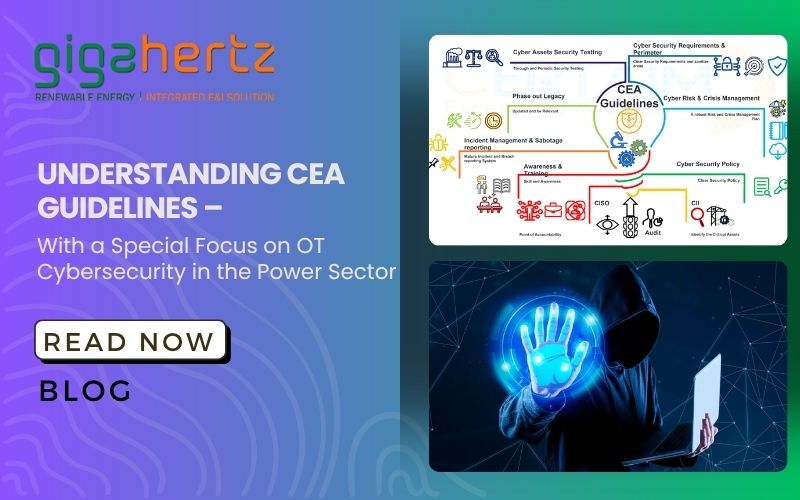
Introduction
India’s power sector is evolving rapidly — driven by renewable integration, digital substations, and smart grid technologies. Amid this transformation, ensuring reliability and cybersecurity of critical infrastructure has become a top national priority.
The Central Electricity Authority (CEA) plays a pivotal role in setting the standards and safety protocols that govern the generation, transmission, and distribution of power across India.
Among these frameworks, Operational Technology (OT) Cybersecurity has emerged as a key focus area, addressing the growing cyber risks to substations, SCADA systems, and grid communication networks.
This blog breaks down the CEA guidelines, highlighting their cybersecurity relevance, practical implications, and best practices for utilities, OEMs, and system integrators.
What is the Central Electricity Authority (CEA)?
The Central Electricity Authority (CEA), under the Ministry of Power, Government of India, was constituted under Section 70 of the Electricity Act, 2003.
It is responsible for advising the government on policies and technical standards to ensure safe, secure, and reliable operation of India’s power infrastructure.
CEA Core Functions:
-
Setting technical and safety standards for electrical systems
-
Overseeing grid connectivity, metering, and energy accounting
-
Ensuring cybersecurity preparedness across power utilities
Key CEA Regulations Impacting the Power Sector
1️⃣ CEA (Technical Standards for Connectivity to the Grid) Regulations
Applies to: Renewable generators, transmission utilities, substations
Key Requirements:
-
Fault Ride Through (FRT) capability (LVRT/HVRT compliance)
-
Reactive power and harmonics control
-
Real-time data exchange with SLDCs using IEC 104 and IEC 61850 protocols
-
Redundant and secure communication links for SCADA and telemetry systems
Cybersecurity Relevance:
Mandates secure data communication and redundancy to prevent disruptions caused by cyber intrusions or communication failures.
2️⃣ CEA (Measures Relating to Safety and Electric Supply) Regulations
Applies to: All electrical installations in India
Key Safety Provisions:
-
Proper clearances and fencing for substation safety
-
Grounding and earthing system design for personnel protection
-
Fire detection, suppression, and emergency response systems
-
Periodic inspections (IR, BDV, EFR tests)
-
Lockout/Tagout (LOTO) procedures for maintenance
Cybersecurity Relevance:
Physical safety extends to cybersecurity — protecting control equipment from unauthorized physical access or tampering.
3️⃣ CEA (Installation and Operation of Meters) Regulations
Applies to: DISCOMs, transmission licensees, and generating companies
Highlights:
-
ABT-compliant and ToD (Time-of-Day) metering
-
Check and standby metering for redundancy
-
Integration with SCADA, AMI, and MDMS systems
-
Data communication using Modbus, DLMS, or IEC-based protocols
Cybersecurity Relevance:
Metering data integrity and secure communication are essential for preventing data manipulation and billing fraud.
4️⃣ CEA Guidelines on Cybersecurity in the Power Sector
Background
With increasing adoption of IEDs, RTUs, IoT, and SCADA systems, India’s power grid has become more digital — and more vulnerable.
To address these evolving risks, the CEA issued the Cybersecurity Guidelines for the Power Sector, aligned with:
-
National Critical Information Infrastructure Protection Centre (NCIIPC)
-
CERT-In Cybersecurity Guidelines
-
IEC 62443 (Industrial Automation & Control Systems Security)
-
NERC-CIP (Critical Infrastructure Protection Standards)
Key Cybersecurity Mandates under CEA Guidelines
| Area | Cybersecurity Requirement |
|---|---|
| Network Design | Segregate IT and OT networks (air-gapped or firewalled) |
| Access Control | Role-Based Access Control (RBAC) and Multi-Factor Authentication (MFA) |
| Monitoring | Real-time log collection, SIEM integration, IDS/IPS deployment |
| Patch Management | Regular SCADA/IED patching through approved change control |
| Incident Response | IR Plan, mock drills, and mandatory reporting to CERT-In |
| Asset Management | Maintain centralized inventory of all OT and IT assets |
| Data Security | End-to-end encryption, secure backups, and audit logging |
SCADA & IED Cybersecurity Best Practices
-
Use TLS encryption for IEC 104 communication
-
Implement GOOSE message authentication in IEC 61850
-
Avoid default passwords on RTUs, PLCs, and gateways
-
Harden operating systems and disable unused services
-
Create logical isolation between generation, control centers, and field substations
Integrating CEA Compliance with Cybersecurity Lifecycle
| Project Stage | CEA + Cybersecurity Integration |
|---|---|
| Design | Define cyber zones (Control Center, DMZ, Field Zone) and secure architectures |
| Implementation | Deploy IEC 62443-compliant hardware and secure communication protocols |
| Operations | Enable patch management, continuous monitoring, and access control |
| Audit | Conduct periodic cybersecurity audits by SLDC/RLDC as per CEA mandates |
Technologies Supporting CEA Cybersecurity Compliance
-
Firewalls & VLANs: Fortinet, Palo Alto, Cisco
-
Network Monitoring & SIEM: Splunk, SolarWinds, IBM QRadar
-
SCADA Systems: GE eTerra, Siemens SICAM, ABB MicroSCADA with secure configurations
-
Protocol Security: Secure Modbus, OPC UA over TLS, IEC 62351
Best Practices for CEA & OT Cybersecurity Readiness
✅ Define network zones — DMZ, OT, and Corporate IT separation
✅ Enable VPNs with Multi-Factor Authentication for remote access
✅ Conduct regular VAPT (Vulnerability Assessment & Penetration Testing)
✅ Train operators against phishing, USB threats, and social engineering
✅ Perform quarterly cybersecurity audits following CEA and NCIIPC guidelines
Must-Read Reference Documents
-
CEA Cybersecurity Guidelines for Power Sector (2024 Edition)
-
CEA Technical Standards for Grid Connectivity
-
CEA Safety Measures for Electrical Installations
-
CEA Metering Regulations (2022 Update)
-
MoP Cybersecurity Framework for Power Utilities
Conclusion
As India accelerates its transition toward digital substations and renewable grid integration, compliance with CEA guidelines and cybersecurity frameworks has become essential for ensuring resilience, reliability, and regulatory readiness.
By aligning with the CEA’s cybersecurity roadmap and global standards like IEC 62443 and NERC-CIP, power utilities can build a Zero Trust OT ecosystem that safeguards assets, minimizes downtime, and fortifies India’s critical power infrastructure for the future.
Category: OT Cybersecurity
